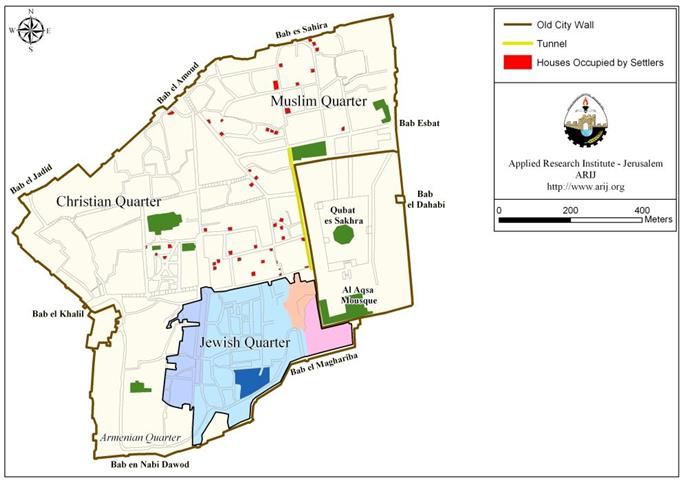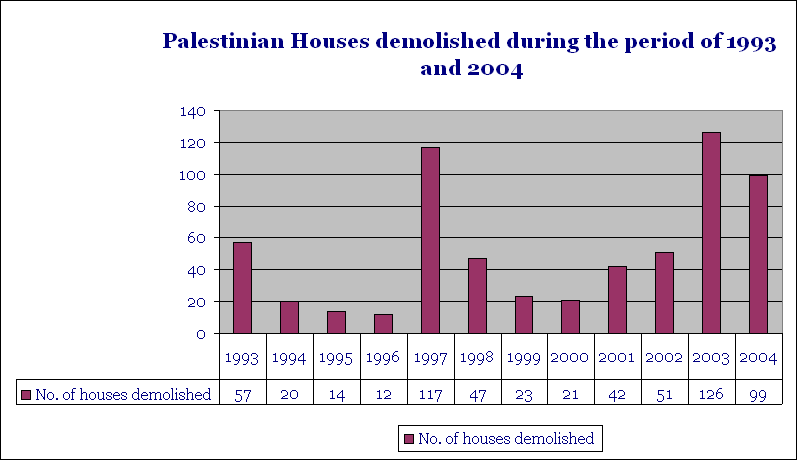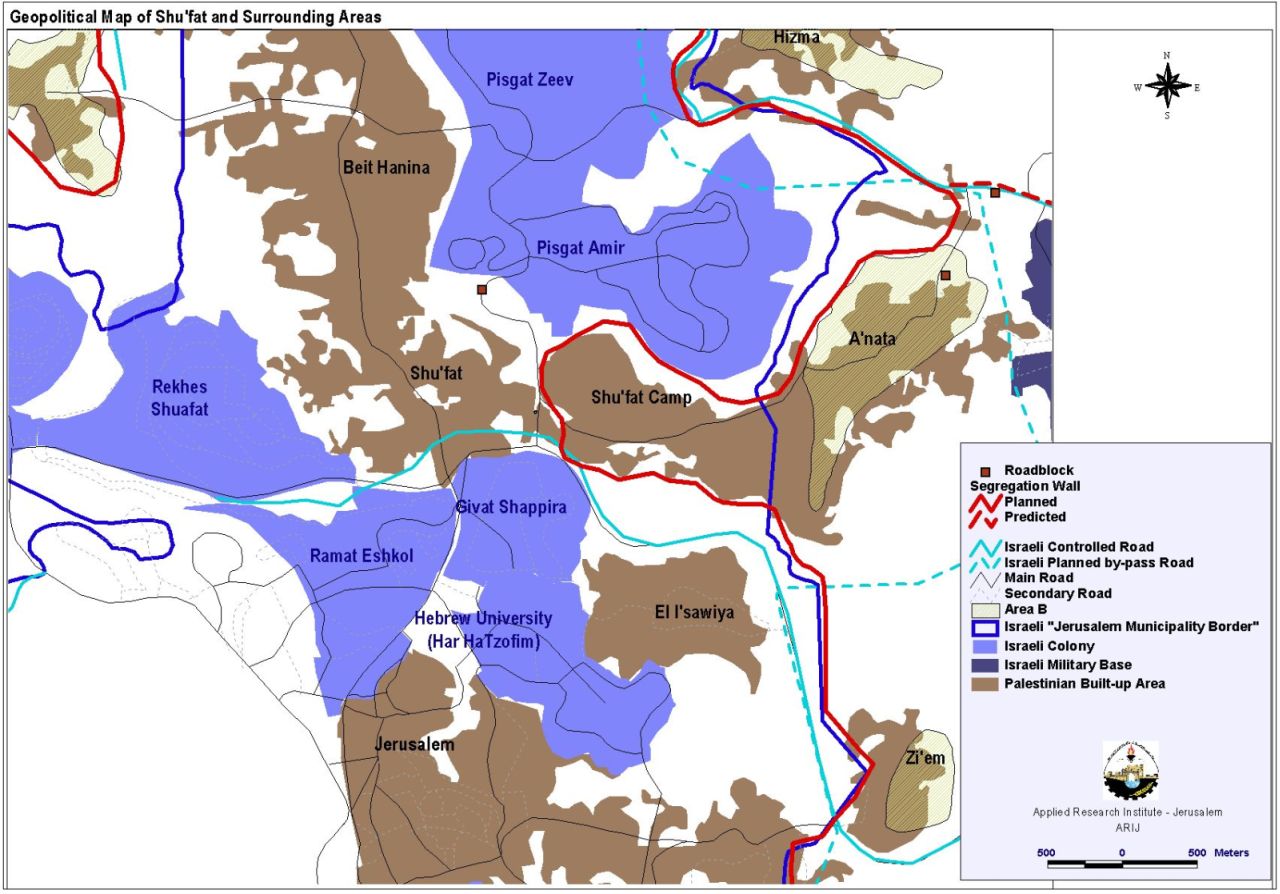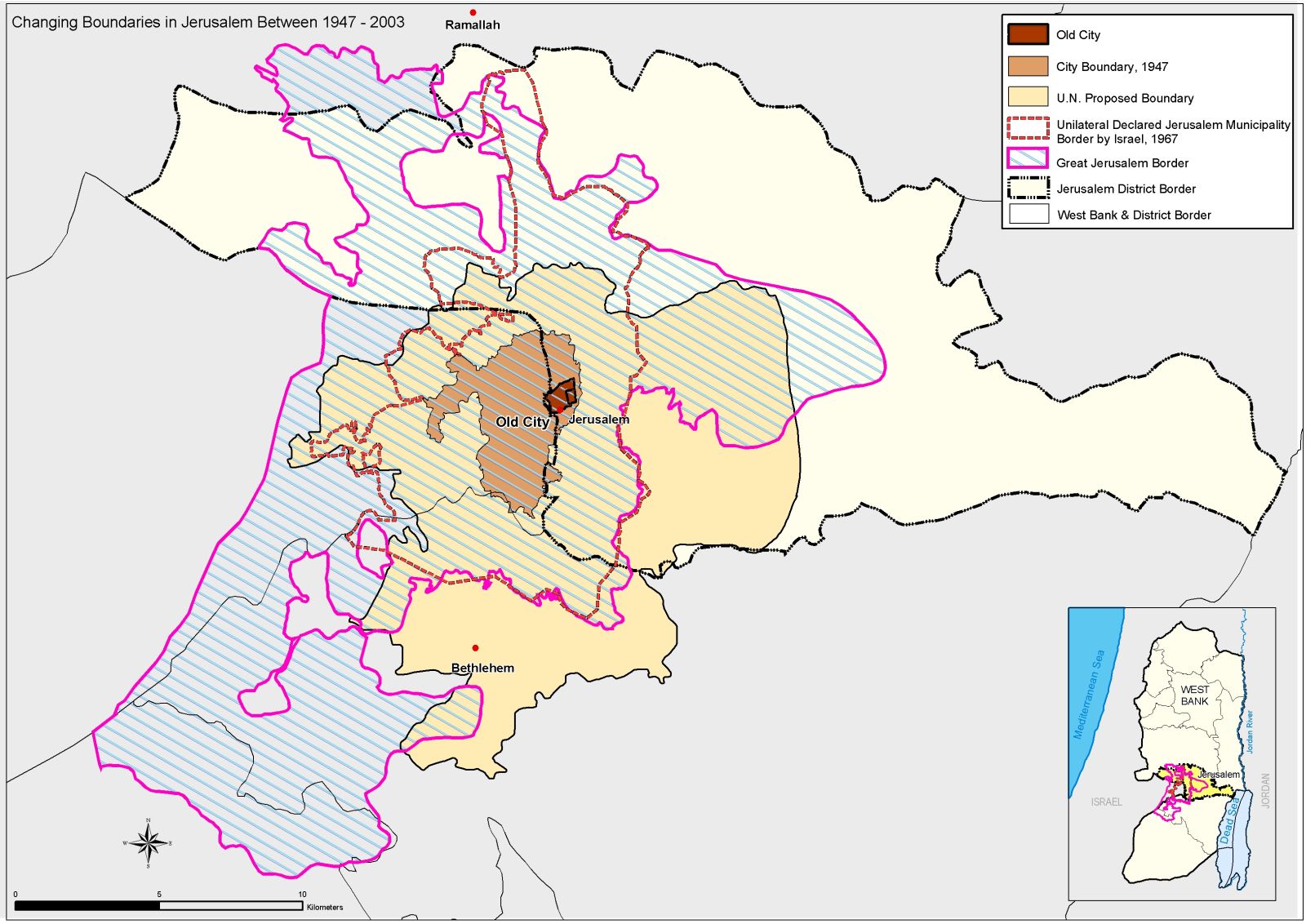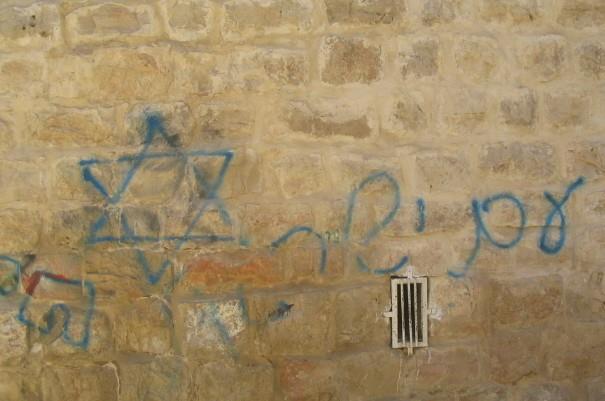Section 1: History and Population
The Old City, situated in the heart of East Jerusalem, is one of the oldest continuously inhabited cities in the world. The Old City of Jerusalem is approximately 5,000 years old. Jerusalem, specifically the Old City, also holds special religious significance for the world's three major monotheistic religions: Judaism, Christianity and Islam. Jerusalem is particularly important to Palestinian Muslims and Christians. The city is the spiritual and cultural center of Palestinian life. Palestinians consider the Old City of Jerusalem to be the most holy city in the world and Jerusalem's name in Arabic, Al Quds, means literally 'The Holy'.
The area of the Old City is 9000 dunums and represents less than 1% of the total area of both East and West Jerusalem. Population densities in the Old City range from 19.1 persons per dunum in the Jewish and Armenian Quarters to over 70 persons per dunum in the Muslim Quarter.
The old city is surrounded by ancient walls and ramparts. Seven gates provide access to the maze of roads and pathways winding through the city. The gates were constructed at various times during the city's long history. The gates are Herod's Gate (Baab Al Sahera), Damascus Gate (Baab Al Amoud), New Gate (Baab Al Jadeed); Jaffa Gate (Baab Al Khalil); Zion Gate (Baab Al Nabi Daoud), Dung Gate (Baab Al Magharbeh); and St. Stephen's Gate or Golden Gate (Baab Al Arahmeh).
East Jerusalem, including the Old City, was seized by Israel during the war of 1967. The area is occupied territory under International Law, specifically the Fourth Geneva Convention of 1949. The Israeli government, however, illegally annexed the territory shortly following its capture. To date, consecutive Israeli governments have refused to accept the Convention in regards to the territories occupied in 1967. Instead, Israel has illegally expanded the municipal boundaries of Jerusalem to include more occupied Palestinian land
Following the occupation and annexation of East Jerusalem, Israeli authorities administratively divided the city along ethnic and religious lines. The city was split into eight 'quarters'. Jerusalem's Old City originally comprised one of these 'quarters'. However, it was subsequently subdivided into an additional four districts which were also divided according to ethnic/religious affiliation, resulting in Muslim, Christian, Armenian, and Jewish 'quarters' within the Old City's walls. The Muslim Quarter was divided again into three further sections- Eastern, Southern and Middle- each of which consists of a number of neighborhoods or Harat. In spite of the ethnic/religious labels, the demographics of each 'quarter' vary. For instance, many Muslims live in the Christian Quarter and vise-versa. The only exception is the Jewish Quarter which the Israeli government renovated exclusively for Jewish Israeli ownership. The Muslim Quarter is the largest of the four quarters, followed by the Christian and the Armenian Quarters, respectively. (See Figure 1: Area by Quarter in the Old City).
Figure 1: Area by Quarters in the OldCity
Table 1: Population distributed in quarters (200)
| Quarter | Population inthousands) | % of Jerusalem totalarea |
| Muslim quarter | 23.7 | 70.5 |
| Christian quarter | 5.2 | 15.5 |
| Armenian quarters | 7.2 | |
| Jewish quarter | 2.3 | 6.8 |
Section 2: Israeli Policies in Occupied East Jerusalem
Following the 1967 war, Israel began to apply an original set of regulations on occupied East Jerusalem and its inhabitants. Israel constructed a legal regime based on the differentiation and subordination of Palestinian East Jerusalemites. These policies were vigorously applied to Palestinians living in the Old City.
In 1967, East Jerusalem had a Palestinian population of 66,000. There was no Israeli presence in the area Since 1967, however, consecutive Israeli governments have implemented an aggressive policy of Israelization of the city. Illegal Israeli settlements have been built in East Jerusalem in order to increase the Jewish Israeli population, preserve the demographic majority of Jewish Israelis within the municipal boundaries and strengthen Israeli sovereignty over East Jerusalem, especially the Old City. Meanwhile, Palestinian Jerusalemites have witnessed a set of discriminatory measures gradually adopted and codified in the legal and bureaucratic policies of the Israeli government. Israel has used these measures to limit the natural growth of Jerusalem's Palestinian population and force migration out of the city. These Israeli policies generally fall into five categories:
-
Restriction of Residency Rights.
-
Discriminatory Tax Systems.
-
Restrictions on Land Use.
-
House Demolitions.
-
Construction of Jewish-only settlements. click here for related articles
Israeli authorities apply each of these policies, to differing degrees, within Jerusalem's Old City. In the Old City, however, the construction of new Israeli settlements is limited by a lack of open space. The Old City's expansion is constrained by its ancient walls and battlements. As a result, the Israelization of the Old City depends to a greater degree upon the forced expulsion of the Palestinian inhabitants mainly by the revocation of residency rights and other bureaucratic measures.
Following the 1967 War only 2.3% of Jerusalem's Palestinian population became Israeli citizens, the vast majority instead became 'permanent residents' of Israeli annexed East Jerusalem Consecutive Israeli governments have adopted a series of policies targeting 'permanent residents'. For instance, 'permanent residents' of East Jerusalem must meet certain criteria in order to maintain their residency rights. If these conditions are not met, residents can have their rights revoked and may lose their residency upon leaving the country for an extended period.
Section 2.1: 'Centre of Life' Regulations
In 1995 Israel's Interior Ministry introduced new regulations requiring East Jerusalemites to provide proof that their 'centre of life' was in Jerusalem. Palestinian residents of East Jerusalem were suddenly required to provide documentation confirming that they have continuously resided in the city for the previous seven years. Palestinians who fail to provide proper documentation lose their residency rights and can be expelled from Jerusalem.
Section 2.2: Taxation
Residents of East Jerusalem are also subject to increased taxation. Israeli authorities collect an 'Arnona tax' on both residential and business locations based on building, office and apartment size. The Arnona tax in Jerusalem is regressive and does not take into consideration differences in income level, family size or other factors. As a result, the tax falls most heavily on Jerusalem's Palestinian population, including residents of the Old City. Those who are unable to pay the taxes face punitive measures such as fines, imprisonment and/or seizure of property. Seized property is subject to State auction. As property values in the Old City are extremely high, these auctions favor Israeli Jewish settler groups that are able to raise funds from various sources. Many of the Old City's Israeli settlements were founded after the property was seized by the Israeli authorities and sold at auction.
Section 2.3: Land Use
A further measure taken against Palestinians in East Jerusalem pertains to planning and zoning restrictions. In the Old City, these restrictions are firmly enforced. Israeli authorities restrict the renovation and expansion of Palestinian owned buildings. JSCER estimates that there are at least 1,400 houses in Jerusalem's Old City that need renovations In contrast, the Jewish quarter has been wholly rebuilt and is continually renovated. Palestinian families, however, are not able to expand their homes and many people are forced to leave the Old City, thus jeopardizing the ability to meet 'centre of life' requirements.
Israeli imposed planning and zoning restrictions require Palestinians to apply for a permit before building a new structure or renovating an existing structure in the Old City.
The Permit process is long, tedious and expensive and disadvantages Palestinian residents of East Jerusalem. Buildings constructed without permits are usually demolished by Israeli authorities. According to studies conducted by ARIJ, a total of 629 Palestinian houses have been demolished in Jerusalem city during the last ten years. Faced with the loss of their homes, many Palestinian families are forced out of the Jerusalem municipal boundaries. The home demolition policy is another method used to force Palestinian Jerusalemites out of the city. Tables III and IV below shows the number of houses demolished in Jerusalem each year.
Tables 2 and Figure 2: House Demolitions in Jerusalem (1993- 2004)
|
Year |
No. of houses demolished |
|
1993 |
57 |
|
1994 |
20 |
|
1995 |
14 |
|
1996 |
12 |
|
1997 |
117 |
|
1998 |
47 |
|
1999 |
23 |
|
2000 |
21 |
|
2001 |
42 |
|
2002 |
51 |
|
2003 |
126 |
|
2004 |
99 |
|
Total |
629 |
Section 2.4: Israeli Colonization of the Old City
Like the rest of the Occupied Palestinian Territories, Jerusalem's Old City has been the site of aggressive Jewish Israeli colonization. With the support of the Israeli government, Israeli settler groups have moved forcefully to appropriate Palestinian buildings in the Old City. As mentioned above, this task is often accomplished by purchasing seized property at auction prices. In 1967, Israel expelled the Palestinian inhabitants of part of the Old City in order to pave the way for the reconstructed Jewish Quarter. Since that time, settlers have gradually taken control of more locations in the Muslim and Christian quarters. There are now more than 60 Jewish Israeli families illegally living in the Palestinian areas of the Old City. (See Map I).
Israeli authorities maintain restrictions on Palestinian expansion and renovation in the Old City while facilitating all procedures for Jewish Israeli settlers to obtain official documentation (Tabo) of properties in Palestinian neighborhoods. Requests made by settlers concerning the renovation and construction of new neighborhoods in the Old City have also been readily approved by the Jerusalem municipality. Recently, settlers have begun to construct new units at Burj Al Luqluq, in the northern sector of the Old City. Burj Al Luqluq is situated on a hilltop in the North-Eastern corner of the city with views of the Mount of Olives and the Al Aqsa Mosque grounds. The new settlement is part of the densely populated Muslim Quarter.
Section 3: Squeezing Palestinians out of Jerusalem
Israeli authorities have made precision moves to encourage Palestinian immigration out of East Jerusalem neighborhoods and the Old City in particular. This strategic objective has been facilitated by a number of methods including, but not limited to, those legal and bureaucratic measures listed above. Palestinians have also been offered financial incentives to leave their homes in the Old City. For example, Israeli authorities recently began to implement a plan to pay Palestinian residents a monetary reward in exchange for leaving their houses in the city and moving to Shu'fat Refugee Camp. In addition to money, Israel is also offering alternative housing in Shu'fat.
Shu'fat Refugee Camp is located east of the city and houses a population of 20,000. It is the only Palestinian refugee camp located inside Jerusalem municipal boundaries. The camp lies between two Israeli settlements, Pisgat Ze'ev and Neve Yacov. The refugees of Shu'fat originate mainly from Palestinian villages which Israel occupied and destroyed in the 1948 war. Most of Shu'fat's residents first lived in Al Sharaf Quarter in the Old City of Jerusalem, where the Jordanian Government provided housing for them after the 1948 war. Soon after the 1967 war, those refugees were expelled by the Israeli authorities for the second time in order to clear the area for the renovated Jewish Quarter. Most of Al Sharaf's refugees ended up in Shu'fat which was established in 1965/1966 over an area of 203 dunums(See map 2).
Map 2: Map of Shu'fat city
Israel has acted in coordination with a strategic plan aimed at maintaining and expanding a Jewish demographic majority within the municipal boundaries of Jerusalem. Currently, Jewish Israelis make up 70% of Jerusalem's total population next to the diminishing 30% Palestinian Population. These numbers are expected to be weighted more heavily in favor of Jewish Israelis upon the completion of the Segregation Wall around Jerusalem is completed. The Wall aims to seal the area known as the ''Jerusalem Envelope' and cut the city off from its surrounding Palestinian suburbs. (see maps 3 and 4).
Maps 3 and 4: Jerusalem Envelope
As of October 2004, more than 30 Km of the Segregation Wall around Jerusalem has been completed while 10 km. are still under construction The Wall promises to isolate many Palestinian neighborhoods in East Jerusalem where an estimated 180,000 Palestinians live. Upon completion, the Wall will threaten many people with the loss of their 'permanent resident' status.
Section 4: Conclusion
Following the 1967 War and the seizure of the Occupied Palestinian Territories by Israeli forces, Israel began to take concerted efforts to colonize the territory of East Jerusalem while subjugating its Palestinian population to ever more restrictive legal and bureaucratic measures. Jerusalem's Old City has seen a magnification of these efforts as Israel continues to exert its will upon the ancient terrain.
Residents of the Old City have witnessed a prolonged campaign to strip them of their residence status and remove them from the city. Israeli authorities have implemented a number of measures in order to encourage Palestinians to leave the Old City. These measures have included 'centre of life' regulations, discriminatory tax schemes, planning and zoning restrictions, house demolitions and even monetary compensation in exchange for property. Meanwhile, the establishment of Jewish Israeli settlements in Palestinian neighborhoods has been aggressively pursued by Israeli settler groups and sternly supported by the Israeli government and Jerusalem municipal authorities.
Israel's current plan for Jerusalem includes the expansion of existing settlements, the establishment of new settlements and the construction of the Segregation Wall. The cumulative effect of such measures make the current Israeli plan the most dangerous to date. With an aim of consolidating and strengthening the Jewish Israeli demographic majority within Jerusalem's municipal boundaries, the current Israeli administration is rapidly creating new facts on the ground and manipulating the outcome of future peace negotiations over the key issue of Jerusalem.
Israel's long-term belligerent occupation of the Palestinian Territories, including East Jerusalem (and the Old City) is a violation of the Fourth Geneva Convention of 1949. In concurrence with this fact, the United Nations General Assembly passed UNGA Resolution 242 on November 22, 1967, calling on Israel to withdraw from the territories occupied in the 1967 war. Both the Convention and Resolution 242 apply to East Jerusalem, including the Old City.
Additionally, Israel's denial of Palestinian rights to live peacefully and securely in their homeland is a blatant violation of bilateral agreements between Israel and Palestinian negotiators. Israel's policy of home demolitions fails to meet the minimum requirements of humanitarian and human rights law. The right to a secure dwelling is codified in the Fourth Geneva Convention of 1949 as well as the International Covenant on Social and Economic Rights and other key documents of International Human Rights Law.
It is clear from an analysis of Israeli actions in East Jerusalem, including the Old City, that Israeli authorities are currently taking concerted efforts to force or 'encourage' the migration of Palestinian residents out of Jerusalem. As a result, Palestinians are being forced to relinquish their status as 'permanent residents' of East Jerusalem. Israeli authorities are also engaged in an effort to facilitate Jewish Israeli colonization of East Jerusalem, including the Old City. These measures constitute the transfer of civilian populations into occupied territories. Article 49 of the Fourth Geneva Convention states that 'The Occupying Power shall not deport or transfer parts of its own civilian population into the territory it occupies.' Such civilian transfers constitute a Grave Breach of the Convention and are prosecutable as War Crimes.
Israeli policies in the Occupied Palestinian Territories have focused upon the aggressive colonization of key strategic and historical locations. The Old City of Jerusalem has been one of these contested locals. The Palestinian residents of Jerusalem are seeking a just peace that guarantees basic human rights and the right of self-determination while Israel is concerned about the security of its own population. However, the security needs of Israel do not trump basic human rights norms. Israel cannot continue to ignore the rights of the Palestinian people as it continues to violate international humanitarian and human rights law.
References:-
[1] Approximately 9 square kilometers and 2,250 acres (1 dunum equals 1,000 square meters and one quarter acre).
[2] Approximately 0.7% of the total area.
[3] These population density figures for the Muslim Quarter do not include the Al Aqsa Mosque compound. If this area is included the figure drops to 52.3 persons per dunum. Source: PASSIA Factsheet 14.5; The Old City. www.passia.org.
[4] For more information on the expansion of Jerusalem's municipal boundaries see PASSIA Factsheet 14.2; Jerusalem, Population. www.passia.org.
[5] welfare association-page.47,67.
[6] According to a 1967 census by the Israeli government, 44,000 people lived within the pre-1967 borders of East Jerusalem and an additional 22,000 lived in the illegally expanded municipal boundary (source: PASSIA Factsheet 14.2; Jerusalem, Population. www.passia.org ).
[7] Jerusalem Center for Social and Economic Rights (JSCER): www.jscer.org.
[8] Jerusalem Center for Social and Economic Rights (JSCER): www.jscer.org.
[9] Palestinian Central Bureau of Statistics
[10] Approximately 0.2 square kilometers or 50 acres.
[11] ARIJ GIS database, 2004.
Prepared by:
The Applied Research Institute – Jerusalem


